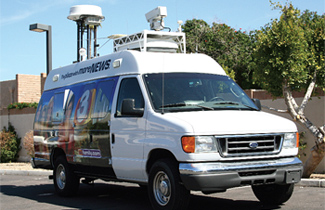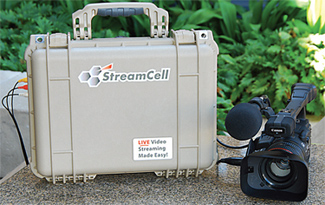Evolution of IP-based ENG
ALEXANDRIA, VA.
Broadcast studios around the country have been successfully employing the technology for file-based workflows and sophisticated network-based automation for just about a decade now. So why is it that stations are still lagging behind the curve when it comes to their remote field operations?
ENG vans, satellite trucks, and remote cameras have yet to fully benefit from a networked digital workflow. The good news is that change is on the horizon. As stations become more comfortable using digital video workflows in-house, they have started to take advantage of using them in the field. Digital microwave links, EVDO, and Wi-Fi have opened up a whole new level of connectivity for field-based IP contribution. Now stations have the ability to transfer large media files rapidly back to the broadcast facility while going live from places not previously accessible to most ENG trucks.
COMPLETING THE DIGITAL LINK

Nucomm Messenger Sure there have been obstacles along the way, such as cost, and the government's BAS relocation effort. But now, broadcasters are not only getting more comfortable with the technology, they are helping to refine it. By rounding out digital transmission and reception systems, stations can take advantage of new technologies, albeit, if sometimes with a bit of skepticism.
Crews in the field have not enjoyed many of the benefits of the file-based workflow that their counterparts in the studio and newsroom have long enjoyed. ENG crews have been acquiring digital assets, but due to the limited bandwidth of cellular-based systems that up to now only linked them to the newsroom computer system, the only way to get media files back to a station was to play the files through a real time microwave link, or else physically transport the media back to the station. Digital satellite and microwave technologies are now beginning to change that.
First on the to-do-list, stations must complete their digital links. "To implement a fully IP-based link using the digital ENG transmitters, stations have had to also upgrade the backhauls from their central receive sites," said John Payne IV, vice president of engineering for RF Extreme in Carlisle, Pa. "Once those are in place, there can be a fully digital link from the ENG truck to the studio."
Payne explained that the large upfront cost to complete a fully digital link between a station's trucks and studio has slowed the migration. Though most TV stations have recently put in digital microwave systems to their receive sites, they often still have an analog link connecting the site back to the studio. Payne attributes this roadblock in part to the economy. "IP simply is not viewed as critical infrastructure right now due," he said.
RF Extreme is the Vitec-owned umbrella company for the microwave products division. They have wrapped familiar names such as Nucomm, RF Central, and MSC all under this new name. Recent efforts resulting from this new group include a suite of products that can take full advantage of IP in the field. RF Extreme's Messenger product is designed to complete and maintain an IP connection from the truck to the studio while enabling everything from file transfer to remote control of the trucks systems.
"The goal of Messenger is to be able to push large files back to the station over the 20 MB of bandwidth available by the digital microwave link," said Payne. Messenger is equipped with an intelligent router that manages IP connectivity from multiple sources to maximize uptime and bandwidth allocation. Inside the Messenger are an EVDO card, a Wi-Fi card, and a connection to the ENG transmitter and DTV receiver. These keep the truck connected to the station via alternate paths, even when the microwave link is powered down.
Similar networking options for satellite trucks have been available from ND Satcom for several years. The company's SkyWAN system establishes a similar connection between a remote truck and studio, but via a satellite-based system rather than terrestrial microwave.
"We create a network in the sky," said Stefan Jucken, ND SatCom's director of sales. The SkyWAN systems can tie multiple trucks together in a network environment, much in the same way as the RF Extreme Messenger, but it has less available bandwidth due to the limitations of the satellite transponder.
AUTOMATING FIELD WORK

NSI's NuPod system incorporates a directional antenna and continuous rotation positioner encapsulated within a non-conductive radome. The NuPod can be remotely controlled by the NSI MC5. Probably the most controversial option offered by both terrestrial and satellite based communications systems is the ability to remote control a vehicle's transmission systems.
"Currently, setting up a live shot typically requires the undivided attention of the operator at the studio as well as the ENG vehicle operator," said Lance Williams, sales manager for NSI in Columbia, Md. "The operator at the studio controls the central receive antenna and monitors the received signal while directing the ENG vehicle operator to pan and tilt the transmit antenna.
Broadcast operations can no longer afford to continue implementing the currently inefficient live shot process."
NSI's MC5 system features a "One Touch" system that automatically aligns the transmit and receive antennas, and powers up and optimizes the connection link at the touch of a button, making it a great time saver for a crew trying to setup for a live shot. The product is EVDO-based, and allows an operator at the studio to select an available remote vehicle and set it up with minimal effort.
The NuComm Messenger system offers some desirable remote control abilities as well. "Multiple trucks can be left in standby during a show and their microwave transmitters can then be remotely turned on and off by the studio," said RF Extreme's Payne. This helps prevent trucks stepping on one another or not powering down fast enough during a busy news cycle.
ND SatCom takes this model to the sky with their Media Fleet Manager system that provides scheduling and control of DVB uplinks originating from SNG vehicles or fixed sites. This allows multiple trucks on a SkyWAN system to be coordinated to the point of sharing segments of a single transponder.
REMOTES BEYOND THE TRUCK
Sometimes a remote truck simply can't get to a feed or live shot location. This may be due to time constraints, terrain, or the length of cable run. To solve this problem, portable IP-based systems are being developed that allow live video to be sent from anywhere that an EVDO or Internet connection can be found.
BitCentral was one of the first to offer this technology with their AirNow system that used two EVDO modems to stream live video back to a station. The product has been spun off to a new company called StreamQuik, run by Ken Lee, BitCentral's former chief technology architect of the AirNow product.

Bitcentral AirNow Now branded the Stream Cell, the new product boasts several improvements over its original model. "The new system uses USB modems rather than PCM-CIA cards, and these can be mixed as 3G or 4G from multiple carriers," Lee said. The product is a single portable box appliance that takes in an analog feed from any camera, encodes it in MPEG-4, and sends a stream using cellular optimization software to a decoder box back at the station. Since most stations have analog to SDI upconversion gear, the output of the decoder box was kept analog to help keep product costs down. For just over $12K, stations can have a low-cost backup solution for remotes. "It is simple to use, no laptop is required and weighing in at only 13 pounds, it is easily carried in its backpack case," Lee said.
VIEW FROM THE FIELD
The promise of many of these technologies has sounded great, though there have been mixed reviews along the way. Some concerns are based on technology, while others have been based on the implementation. When the products work as advertised, they make a tremendous difference to the ENG effort.
Ken Lee relates a success story: "During the Honolulu elections, KHON could not get a cable from their truck into the facility and ended up using the AirNow to get four live shots out." NSI's Lance Williams has also had positive client feedback where "operators are now fighting over who gets to drive the truck with the One Touch Auto Link."
Opinions expressed on The SNG Forum, a longstanding idea exchange Web site for TV and Satellite professionals, have been mixed. Leland Kesler, the site's moderator has seen mixed reviews and as a truck operator himself has had varied experiences.
"As for me, the auto finding remote control systems for satellite trucks appear to be buggy," Kessler said. "I have seen two situations where the system failed to acquire the satellite." This can be an issue if a trained operator is not readily available to backup the automated system. This would apply for ENG as well as SNG work.
The concern Kessler has about EVDO-based systems is the reliance on a common carrier's capacity. Anyone who has tried to place a call at a major event and failed knows how quickly cell sites can fill up. "iPhones are choking AT&T's system in many areas, so imagine what will happen when broadcasters begin trying to stream high-quality video over these already maxed-out systems," Kessler said.
This is where the benefit of the dedicated bandwidth through a digital microwave can provide the system dependability demanded by broadcasters.
The technology and infrastructure elements are now available to implement complete IP connectivity to the field. Each option mentioned above offers specific benefits, but some come with limitations or high costs. When used in conjunction with existing systems and properly trained crews, they can greatly increase the productivity and flexibility of the ENG team.
Get the TV Tech Newsletter
The professional video industry's #1 source for news, trends and product and tech information. Sign up below.
